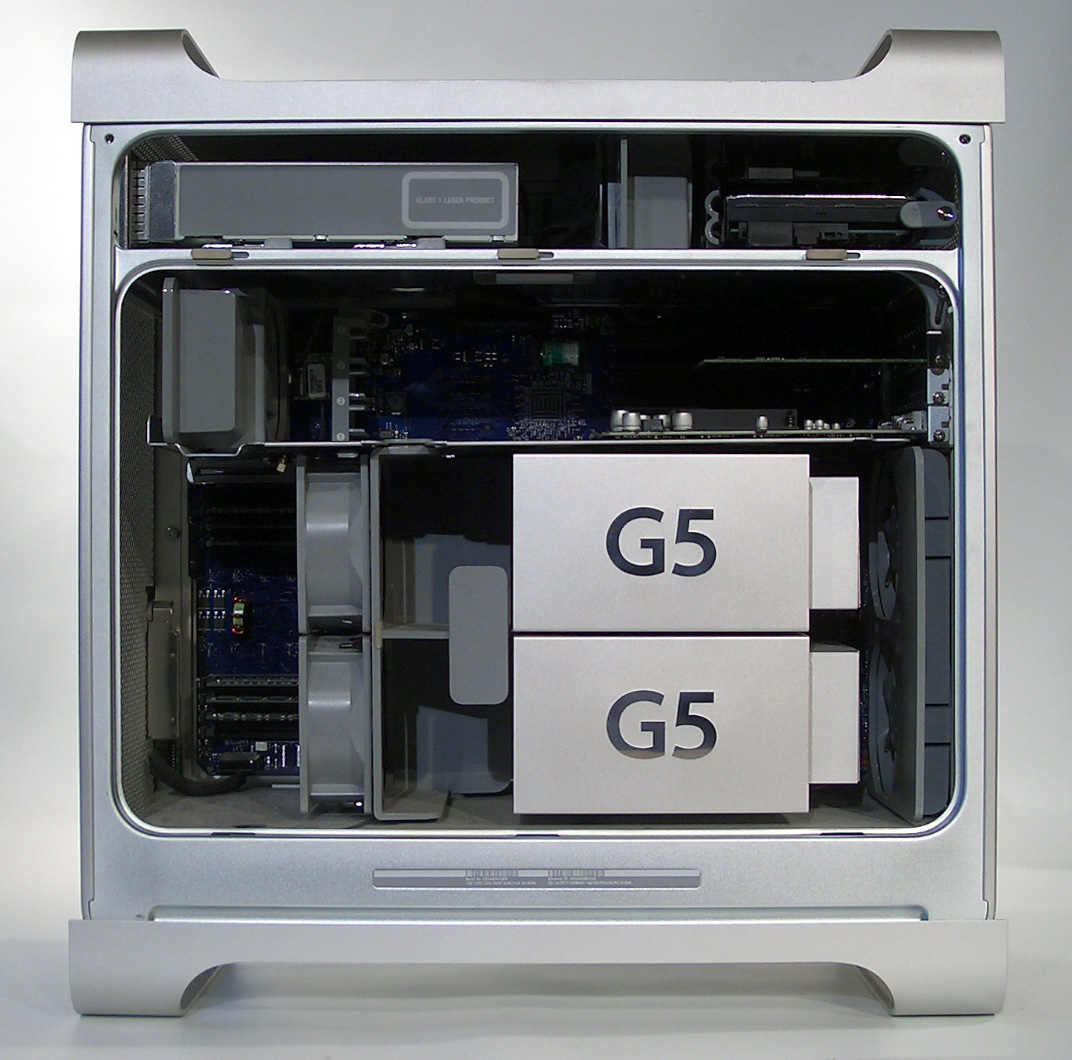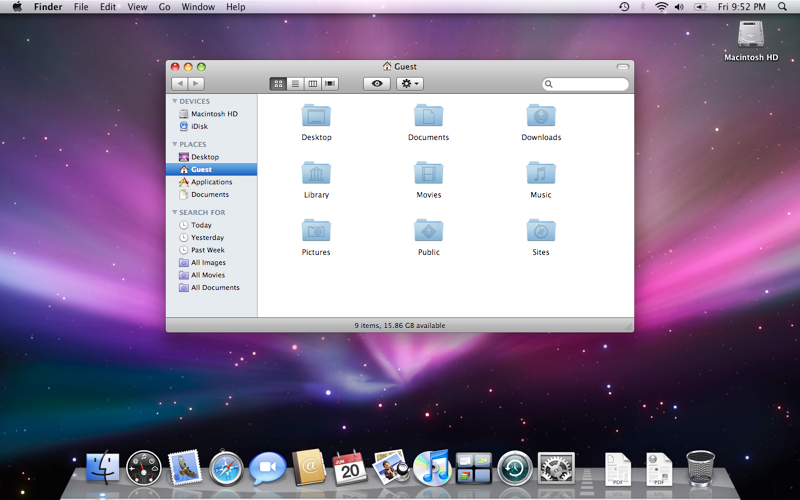A few months ago I bought an old PowerMac G5 off of Craigslist and since then I have been experimenting with various operating systems and configurations. Before I tell you more about these, let me briefly explain why I got such a machine.
I had always wanted one of these beasts. They look gorgeous (to me) and, to convince myself to get it, I thought that I would play with the PPC64 architecture. How? By getting NetBSD to run properly on these machines while learning enough to iron out the few rough edges that I thought were left. Unfortunately, that story didn’t go well (more below), so I ended up experimenting with various other operating systems.
In this post, I briefly review my experiences with the various configurations I have tried and give some recommendations as to what might work better for you.
This specific PowerMac G5 is a dual PPC 970FX 2Ghz with 6GB of RAM, two SATA hard drives and an ATI Radeon 9600 XT AGP. The machine is air-cooled and is louder than I had expected; the noise is high enough to be bothersome if left running all day long in the living room. That said, in winter, it serves as a cool-looking space heater (really).
Let’s get started with the review.
Debian GNU/Linux (Wheezy and Jessie)
This is, simply put, the best choice if what you want is an operating system that “just works” out of the box and that comes with modern software. Getting Debian installed is as easy as recording an installation image onto a USB drive or a CD-ROM, booting off either and following the traditional Debian installation procedure. After the system is up and running, pretty much all hardware works and the machine feels quite snappy.
Both Firefox and Midori, which are the two modern web browsers available for Linux powerpc that I know of, work “OK”. They are a bit sluggish, particularly when the rendering window is larger than about half of the screen surface, but they may be bearable.
The only problem I have encountered so far is poor support for nVidia cards. Yes, I mentioned above this machine has a Radeon card, but it came with an nVidia card when I bought it. There obviously is no official binary driver for Linux for this platform, and the Nouveau X.org driver is riddled with big-endian issues that make it unusable. I could have spent time trying to track the problems down, but instead I bought a replacement card — the Radeon that I have now — off eBay which made the system work flawlessly. Unfortunately, Gnome 3 still refuses to work with such a card, but any other graphical environment works fine. (Not that I care much about Gnome any longer, but I was hoping to be able to play with it a little bit. So far, I have not been able to do so on any of the machines I own!) KDE 4 behaves reasonably well, and any simpler environment just flies.
Fedora (19)
There are PowerPC builds of Fedora available on the website although I haven’t had any success with them. On the first hand, writing an ISO image to a USB stick as the installation procedure explains results in an unbootable installer… which is expected given that various configuration files in the image hardcode paths to the CD. Recording the image to a real CD and booting from it works as intended.
Once in the installer, there is no SMU support so the fans of the machine will run like crazy during the whole installation procedure. As far as I have encountered online, this problem should go away once the system is installed, but I have been unable to confirm this.
The biggest pain is that the installer does not deal well with the boot process of a Mac. The new Anaconda in Fedora 19, unfortunately, is quite hard to deal with and the partitioning tools don’t work well: it is really hard to create an Apple_Bootstrap partition from the UI that “works”, as it involves several hacks (like going to the console and unmounting a file system half-way through the installation). With some handholding, I could finally get the system installed but it would just not boot from the hard disk later on. Eventually I just gave up.
FreeBSD (9.1 and 10.0-CURRENT)
Much to my surprise, FreeBSD works very well on powerpc64 machines despite it having been an x86-only operating system for many years. Writing the memstick image onto a USB and booting from it is easy, the installer “just works” and the system does so too after booting into it.
Unfortunately, at least on my machine, there seems to be a problem with the SMU driver that makes the machine turn off when building pcre (and only pcre so far). I suspect this is a bug in the driver because the machine is rock solid otherwise with this and other operating systems.
Regardless of this minor annoyance, I have been able to set up a pretty decent development machine with shiny bells and whistles like ZFS.
Mac OS X (Leopard)
Obviously, the native operating system for the Mac is the one with the best hardware support for this machine. Keep in mind that the latest release you can get to run on a PowerPC-based machine is Leopard, which is a 6-year old system.
On the bright side, the system feels snappy because the software hasn’t gotten any bloat for a long time.
On the down side, you are stuck with a stale release on which most modern third-party software does not work. Keep in mind that most software nowadays use APIs only available after Leopard, and that the binaries are no longer built for PowerPC. This is a problem with, for example, Firefox: you are left to use a really ancient release that is probably riddled with security issues.
Edit: atomicules@ lets me know on Twitter that the TenFourFox and Leopard-webkit projects provide up-to-date browsers for PowerPC-based macs. Neat.
NetBSD (6.99.x)
This is the sad bit of this post. NetBSD claims to support the G5 in 32-bit mode only, but in reality the macppc port does not work at all on, at least, my specific PowerMac G5 model. Problems start right from the bootloader, which is unable to properly load a kernel. Applying some still-unofficial patches give the bootloader a chance to make some more progress, but then the kernel fails miserably to do anything useful. Even with all this fixed, you are still left with a 32-bit based OS running on this 64-bit capable machine, which means the amount of RAM you can use is limited, among other things.
Summary
If you just want to use the machine as it was built and experience some not-so-old times, go for the original OS X Leopard. If you do that, be aware that you’ll have to cope with outdated software and that such software is most likely plagued by security holes. Better to not connect the machine to the Internet.
If you want to make the most of the machine for desktop use, go for Debian. Note that some other distributions might work as well, but I have not tried them.
If you want to use the machine as a server or development machine, go for any of Debian or FreeBSD. Both work equally well in this area.
And, with this, we’ll resume the readability series next Thursday.
Image credits: Wikipedia.



